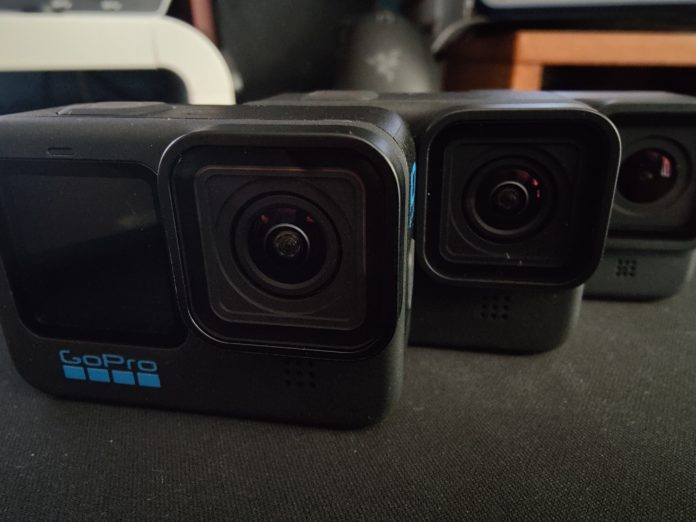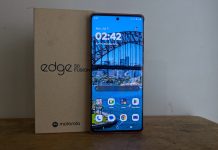If you’re into adventurous activities, the odds are you have (or want) a GoPro or one of its competitors. Last year we saw a step away from the traditional action camera mould that GoPro holds towards a blogging setup. This year there are several leaps forward in the capabilities of the GoPro Hero 10 Black that are largely invisible but contribute greatly to the user experience.
The look and features
The specs of the GoPro Hero 10 Black were covered as part of the launch a couple of weeks ago. There are a couple of the upgraded features worth quickly revisiting, if for no other reason than they’re mighty impressive.
The video resolution now peaks at a whopping 5.3K with 23-megapixel photos and a number of capture modes available to maximise the capture capabilities of the camera. This is through the same sensor that the Hero 9 Black had, but the GP2 chip (more on this later) gives the camera better processing capabilities. This brings the video frame rates up to:
- 60 FPS at 5.3K 16:9
- 120 FPS at 4K
- 240 FPS at 2.7K
The camera itself is — as was the Hero 9 — waterproof to 33 feet without a case and the lens has been upgraded with a “hydrophobic” coating. This doesn’t mean the camera is afraid of water, rather the water tends to run off the lens cover far more readily than previous models which: Has traditionally been a cause of many ruined videos with water spots on the lens.
The Hero 10 Black has the exact same dimensions as the Hero 9. For buyers well invested in last years model, it makes the accessories you’ve purchased compatible with the new model. If you sit the Hero 9 Black next to the Hero 10 Black, visibly there are previous few differences.
The front-facing Vlogger screen has improved a bit from the Hero 9. In part — again — thanks to the GP2 chips allowing faster processing and in part the better panel itself that runs at slightly higher resolution. This results in a clearer image and better frame rates (30 FPS vs 20 last year) that make the screen far more useful for framing your video, as well as understanding what the end result of your efforts will look like on a larger screen.
GP2 brings so much more to the whole experience
During the press briefing, much of the focus was on the GP2 processor and after a couple of weeks with the camera, we can see why. We’ve already mentioned the improved frame rates on videos and slightly higher resolution, but there’s more GP2 brings to the party.
Hypersmooth 4.0 – onboard stabilization got even better!
As the name suggests, this is the fourth iteration of GoPro’s hypersmooth technology which — for those unaware — is video stabilisation. With each iteration, it has improved significantly and now the need for a gimbal is essentially non-existent. This doesn’t just smooth out the video if you’re running on bumpy tracks, riding a mountain bike or driving a car on some adventurous activities – it levels the horizon for stable videos.
The above video was filmed by simply using the included shorty, no gimbal or other stabilization other than HyperSmooth was used while riding a scooter
This is where some users may want to occasionally turn off horizon levelling though as it reduces some of the dynamic feels of the video. By levelling the horizon on — for instance — a video from a motorbike track day, or mountain bike downhill ride, the video can seem far more serene than the actual experience. Sure the video is HyperSmooth (see what I did there?) but it’s not giving the viewer a true indication of the experience.
Faster downloading and navigation
There are, as always, variables in the ultimate end result but the downloading of media from your GoPro is now faster, easier and has more options to do so. Let’s start with the new way to download your media: It’s via cable offload and it’s pretty darn quick, significantly faster than the apps Wi-Fi download option. It is, unfortunately, limited to mobile devices for offload.
Wi-Fi downloading has benefited greatly from the upgraded chip, now noticeably quicker to download video than the predecessor in the Hero 9. This is very much driven by your phone as well as GP2, but the bottleneck is no longer the camera’s capacity to throw data at your phone.
Navigation is smooth and consistent
If you’ve used a previous generation GoPro you’ll be familiar with the menu navigation lag. While it’s not always horrendous, it is ever-present and does cause frustration with the need to try and re-try navigation buttons multiple times. Instead of being the norm with the Hero 10 Black, it’s by far the exception to have to retry menu navigation: During our testing, there were less than a dozen instances of this occurring and usually after prolonged operation.
Performance is up but it’s not perfect
While the battery life isn’t a strong suit for GoPro, in honesty it’s never been great, the GoPro Hero 10 Black has taken a bit of a hit. In fairness though, that also makes a lot of sense since with the same battery capacity, the new camera is producing:
- Higher resolution videos
- Higher FPS for videos
- Better colour reproduction
- Greater light capture capacity
- Holistically, better video capture and processing
But that does mean that as a user, you’ll need to ensure you’ve got a spare battery or two with you if you’re planning on lengthy video capture sessions. This is the exception to the rule, where generally GoPro cameras are used for capturing short bursts of action.
In our testing, it became apparent that about an hour and 15 minutes at full resolution was the limit at full capacity of the camera. There are significant jumps in battery life if you wind down the video quality to 4K, even more so at 2.7K so it’s not a massive deal-breaker that’s for sure – but worth sharing the information that’s for sure.
Video and image quality
While we’ve essentially covered it through the article as a whole, there’s a lot of upgrades here with the GoPro Hero 10 Black. It really is an outstanding piece of kit that deserves recognition and its place atop the field of action cameras. You’re getting better resolution, higher frame rates, better colour and light capture, better video stabilisation, easier offloading of your footage and a more user-friendly interface.
Should you buy one?
Yes, but there’s a bit of an “if” in this answer. Yes, you should buy one, but if you’re looking for a big upgrade from the Hero 9 Black it’s probably not worth the money. If you’ve broken your Hero 9, sure upgrade or here are other reasons that I’d seriously look to buying the Hero 10 Black:
- You’re buying your first GoPro
- You’re upgrading from a Hero 8 Black
- You’re after another camera to capture your adventures
Similar to last year GoPro has done something very smart in offering significant discounts. The discounts are valid only if you’ve got – or are prepared to sign up for – a GoPro subscription. Frankly, if you want to buy the camera without a subscription, you’re burning money.
This isn’t the cheapest GoPro Camera that the company has ever released. The camera alone will cost $599.95 with a subscription, or $749.95 without. If you want to grab the bundle that includes a shorty (tripod/selfie stick), extra battery, case and swivel clip you’ll be parting with $699.95 with a subscription or $829.95 without. A point of note in the packaging that GoPro delivers now is that there is no single use plastic or wrappings – Making the GoPro Hero 10 Black not just brilliant but sustainable.
The upshot is that GoPro has, again, delivered an exceptionally solid evolution to their market leading camera with the Hero 10 Black. The biggest advancement is the GP2 which makes not just the video footage, but the user experience a significantly better one.
Disclosure Statement
GoPro has not requested return of the unit at completion of the review.












